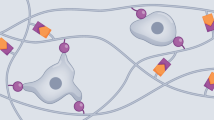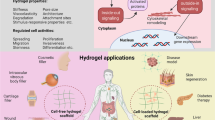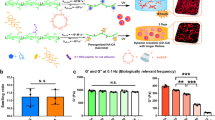Abstract
Cells can deform their local niche in three dimensions via whole-cell movements such as spreading, migration or volume expansion. These behaviours, occurring over hours to days, influence long-term cell fates including differentiation. Here we report a whole-cell movement that occurs in sliding hydrogels at the minutes timescale, termed cell tumbling, characterized by three-dimensional cell dynamics and hydrogel deformation elicited by heightened seconds-to-minutes-scale cytoskeletal and nuclear activity. Studies inhibiting or promoting the cell tumbling of mesenchymal stem cells show that this behaviour enhances differentiation into chondrocytes. Further, it is associated with a decrease in global chromatin accessibility, which is required for enhanced differentiation. Cell tumbling also occurs during differentiation into other lineages and its differentiation-enhancing effects are validated in various hydrogel platforms. Our results establish that cell tumbling is an additional regulator of stem cell differentiation, mediated by rapid niche deformation and nuclear mechanotransduction.
This is a preview of subscription content, access via your institution
Access options
Access Nature and 54 other Nature Portfolio journals
Get Nature+, our best-value online-access subscription
27,99 € / 30 days
cancel any time
Subscribe to this journal
Receive 12 print issues and online access
269,00 € per year
only 22,42 € per issue
Buy this article
- Purchase on SpringerLink
- Instant access to full article PDF
Prices may be subject to local taxes which are calculated during checkout






Similar content being viewed by others
Data availability
The data supporting the findings of the study are available in the Article and its Supplementary Information. The ATAC-seq experiment data are available in GEO accession GSE239277 (https://www.ncbi.nlm.nih.gov/geo/query/acc.cgi). Raw imaging data are available from the corresponding author upon request owing to large file sizes and numbers. Source data are provided with this paper.
Code availability
All new code written for the paper can be accessed via GitHub at https://github.com/Stanford-Fan-Yang-lab/CellTumbling.
References
Saraswathibhatla, A., Indana, D. & Chaudhuri, O. Cell–extracellular matrix mechanotransduction in 3D. Nat. Rev. Mol. Cell Biol. 24, 495–516 (2023).
Wisdom, K. M. et al. Matrix mechanical plasticity regulates cancer cell migration through confining microenvironments. Nat. Commun. 9, 4144 (2018).
Sinha, S., Ayushman, M., Tong, X. & Yang, F. Dynamically crosslinked poly(ethylene-glycol) hydrogels reveal a critical role of viscoelasticity in modulating glioblastoma fates and drug responses in 3D. Adv. Healthc. Mater. 12, 2202147 (2023).
Loebel, C., Mauck, R. L. & Burdick, J. A. Local nascent protein deposition and remodelling guide mesenchymal stromal cell mechanosensing and fate in three-dimensional hydrogels. Nat. Mater. 18, 883–891 (2019).
Lee, H.-P., Stowers, R. & Chaudhuri, O. Volume expansion and TRPV4 activation regulate stem cell fate in three-dimensional microenvironments. Nat. Commun. 10, 529 (2019).
Khetan, S. et al. Degradation-mediated cellular traction directs stem cell fate in covalently crosslinked three-dimensional hydrogels. Nat. Mater. 12, 458–465 (2013).
Lee, H.-P., Gu, L., Mooney, D. J., Levenston, M. E. & Chaudhuri, O. Mechanical confinement regulates cartilage matrix formation by chondrocytes. Nat. Mater. 16, 1243–1251 (2017).
Nam, S. et al. Cell cycle progression in confining microenvironments is regulated by a growth-responsive TRPV4-PI3K/Akt-p27Kip1 signaling axis. Sci. Adv. 5, eaaw6171 (2019).
Dai, E. N., Heo, S.-J. & Mauck, R. L. ‘Looping in’ mechanics: mechanobiologic regulation of the nucleus and the epigenome. Adv. Healthc. Mater. 9, 2000030 (2020).
Dupont, S. & Wickström, S. A. Mechanical regulation of chromatin and transcription. Nat. Rev. Genet. 23, 624–643 (2022).
Kalukula, Y., Stephens, A. D., Lammerding, J. & Gabriele, S. Mechanics and functional consequences of nuclear deformations. Nat. Rev. Mol. Cell Biol. 23, 583–602 (2022).
Lomakin, A. J. et al. The nucleus acts as a ruler tailoring cell responses to spatial constraints. Science 370, eaba2894 (2020).
Venturini, V. et al. The nucleus measures shape changes for cellular proprioception to control dynamic cell behavior. Science 370, eaba2644 (2020).
Balaban, N. Q. et al. Force and focal adhesion assembly: a close relationship studied using elastic micropatterned substrates. Nat. Cell Biol. 3, 466–472 (2001).
Blanchoin, L., Boujemaa-Paterski, R., Sykes, C. & Plastino, J. Actin dynamics, architecture, and mechanics in cell motility. Physiol. Rev. 94, 235–263 (2014).
Tong, X. & Yang, F. Sliding hydrogels with mobile molecular ligands and crosslinks as 3D stem cell niche. Adv. Mater. 28, 7257–7263 (2016).
Krajina, B. A. et al. Dynamic light scattering microrheology reveals multiscale viscoelasticity of polymer gels and precious biological materials. ACS Cent. Sci. 3, 1294–1303 (2017).
Cai, P. C. et al. Dynamic light scattering microrheology for soft and living materials. Soft Matter 17, 1929–1939 (2021).
Ho, A. D., Wagner, W. & Franke, W. Heterogeneity of mesenchymal stromal cell preparations. Cytotherapy 10, 320–330 (2008).
Welf, E. S. et al. Actin-membrane release initiates cell protrusions. Dev. Cell 55, 723–736.e728 (2020).
Walker, C. J. et al. Nuclear mechanosensing drives chromatin remodelling in persistently activated fibroblasts. Nat. Biomed. Eng. 5, 1485–1499 (2021).
Seelbinder, B. et al. Nuclear deformation guides chromatin reorganization in cardiac development and disease. Nat. Biomed. Eng. 5, 1500–1516 (2021).
Killaars, A. R., Walker, C. J. & Anseth, K. S. Nuclear mechanosensing controls MSC osteogenic potential through HDAC epigenetic remodeling. Proc. Natl Acad. Sci. USA 117, 21258–21266 (2020).
Killaars, A. R. et al. Extended exposure to stiff microenvironments leads to persistent chromatin remodeling in human mesenchymal stem cells. Adv. Sci. 6, 1801483 (2019).
Stowers, R. S. et al. Matrix stiffness induces a tumorigenic phenotype in mammary epithelium through changes in chromatin accessibility. Nat. Biomed. Eng. 3, 1009–1019 (2019).
Madl, C. M., LeSavage, B. L., Khariton, M. & Heilshorn, S. C. Neural progenitor cells alter chromatin organization and neurotrophin expression in response to 3D matrix degradability. Adv. Healthc. Mater. 9, 2000754 (2020).
Swift, J. et al. Nuclear lamin-A scales with tissue stiffness and enhances matrix-directed differentiation. Science 341, 1240104 (2013).
Buxboim, A. et al. Matrix elasticity regulates lamin-A,C phosphorylation and turnover with feedback to actomyosin. Curr. Biol. 24, 1909–1917 (2014).
van Steensel, B. & Belmont, A. S. Lamina-associated domains: links with chromosome architecture, heterochromatin, and gene repression. Cell 169, 780–791 (2017).
Pauler, F. M. et al. H3K27me3 forms BLOCs over silent genes and intergenic regions and specifies a histone banding pattern on a mouse autosomal chromosome. Genome Res. 19, 221–233 (2009).
Cai, Y. et al. H3K27me3-rich genomic regions can function as silencers to repress gene expression via chromatin interactions. Nat. Commun. 12, 719 (2021).
Nava, M. M. et al. Heterochromatin-driven nuclear softening protects the genome against mechanical stress-induced damage. Cell 181, 800–817.e822 (2020).
Creyghton, M. P. et al. Histone H3K27ac separates active from poised enhancers and predicts developmental state. Proc. Natl Acad. Sci. USA 107, 21931–21936 (2010).
Norris, K. L., Lee, J.-Y. & Yao, T.-P. Acetylation goes global: the emergence of acetylation biology. Sci. Signal. 2, e76–pe76 (2009).
Buenrostro, J. D., Giresi, P. G., Zaba, L. C., Chang, H. Y. & Greenleaf, W. J. Transposition of native chromatin for fast and sensitive epigenomic profiling of open chromatin, DNA-binding proteins and nucleosome position. Nat. Methods 10, 1213–1218 (2013).
Corces, M. R. et al. An improved ATAC-seq protocol reduces background and enables interrogation of frozen tissues. Nat. Methods 14, 959–962 (2017).
Enyedi, B., Jelcic, M. & Niethammer, P. The cell nucleus serves as a mechanotransducer of tissue damage-induced inflammation. Cell 165, 1160–1170 (2016).
Itano, N., Okamoto, S.-I., Zhang, D., Lipton, S. A. & Ruoslahti, E. Cell spreading controls endoplasmic and nuclear calcium: a physical gene regulation pathway from the cell surface to the nucleus. Proc. Natl Acad. Sci. USA 100, 5181–5186 (2003).
Kita-Matsuo, H. et al. Lentiviral vectors and protocols for creation of stable hESC lines for fluorescent tracking and drug resistance selection of cardiomyocytes. PLoS ONE 4, e5046 (2009).
Mayer, C. R., Arsenovic, P. T., Bathula, K., Denis, K. B. & Conway, D. E. Characterization of 3D printed stretching devices for imaging force transmission in live-cells. Cell. Mol. Bioeng. 12, 289–300 (2019).
Thielicke W., Stamhuis E. J. PIVlab—towards user-friendly, affordable and accurate digital particle image velocimetry in MATLAB. J. Open Res. Softw. 2, 30 (2014).
Breese, M. R. & Liu, Y. NGSUtils: a software suite for analyzing and manipulating next-generation sequencing datasets. Bioinformatics 29, 494–496 (2013).
Li, H. et al. The Sequence Alignment/Map format and SAMtools. Bioinformatics 25, 2078–2079 (2009).
Zhang, Y. et al. Model-based Analysis of ChIP-Seq (MACS). Genome Biol. 9, R137 (2008).
Hoffman, M. M. et al. Integrative annotation of chromatin elements from ENCODE data. Nucleic Acids Res. 41, 827–841 (2013).
Love, M. I., Huber, W. & Anders, S. Moderated estimation of fold change and dispersion for RNA-seq data with DESeq2. Genome Biol. 15, 550 (2014).
Acknowledgements
We would like to acknowledge NIH grant nos. R01DE024772 (F.Y.) and R01AR074502 (F.Y.) and the Stanford Bio-X Interdisciplinary Initiative Program (F.Y.) for grant support. M.A. would like to thank Bio-X Stanford Interdisciplinary Graduate Fellowship for support. S.S. would like to thank the NIH F31 predoctoral fellowship (no. 5F31CA246972-02) and Stanford NIH Biotechnology training program for support. We would like to thank N. Su, J. Lee and S. Kim for their helpful discussions, T. T. Susanto for help with the plasmid midiprep and the Chaudhuri Lab at Stanford University for kindly allowing the use of their laboratory’s rheometer. We would like to acknowledge the Stanford Gene Vector and Virus Core (GVVC) for plasmid lentivirus packaging.
Author information
Authors and Affiliations
Contributions
M.A., X.T. and F.Y. conceived the study design. M.A., G.M., X.T. and S.S. performed the experiments. G.M. wrote all the new codes for image analysis with input from M.A. M.A., E.L.-F. and A.S.-C. conducted the ATAC-seq experiment design and data analysis. M.A., P.C.C., A.S. and S.C.H. conducted the microrheology characterization and data analysis. X.T., H.-P.L. and M.A. performed the AFM experiment and analyses. S.J. and X.T. conducted the polymer synthesis and characterization. A.J.M. participated in the experimental design of characterizing the chromatin state and accessibility. F.Y. supervised the study. M.A. and F.Y. wrote the manuscript with inputs from all authors.
Corresponding author
Ethics declarations
Competing interests
The authors declare no competing interests.
Peer review
Peer review information
Nature Materials thanks the anonymous reviewers for their contribution to the peer review of this work.
Additional information
Publisher’s note Springer Nature remains neutral with regard to jurisdictional claims in published maps and institutional affiliations.
Extended data
Extended Data Fig. 1 Quantification of cell tumbling and nuclear movements upon cytoskeleton inhibition and LINC complex inhibition.
(a) (Left) Centroid speed and (Right) Major axis angular speed upon cytoskeletal inhibition. N ≥ 15 across 3 gels per condition (b) Nuclear movement speed upon cytoskeleton inhibition. N ≥ 20 across 3 gels per condition. (c) (Left) Centroid speed and (Right) Major axis angular speed upon LINC complex inhibition. N ≥ 15 across 3 gels per condition. (d) Nuclear movement speed (5-minute intervals for a total period of 16 hours) upon LINC complex inhibition. N ≥ 20 across 3 gels per condition. ns, not significant; *p < 0.05, **p < 0.005, ***p < 0.001, ****p < 0.0001. P value, one–way ANOVA with Tukey’s multiple comparisons test.
Extended Data Fig. 2 Characterization of focal adhesions and the role of adhesive ligands in cell tumbling.
(a) Representative immunofluorescence images for focal adhesion markers in SG (top) and CG (bottom) after 24 hours of chondrogenic induction and Fibronectin after 12 hours of chondrogenic induction as observed from 3 independent experiments. Marker of interest- green, F-Actin- red, and DAPI- blue. Scale- 10μm. (b) Centroid speed and (c) Major axis angular speed upon perturbation of adhesive ligands. N ≥ 15 across 3 gels per condition (d) Nuclear movement speed upon perturbation of adhesive ligands. N ≥ 20 across 3 gels per condition. ns, not significant; *p < 0.05, **p < 0.005, ***p < 0.001, ****p < 0.0001. P value, one–way ANOVA with Tukey’s multiple comparisons test.
Extended Data Fig. 3 Characterization of Ezrin in cell tumbling.
Note- NSC is the Ezrin inhibitor NSC668394. (a) Representative western blotting images and (b) Quantifications of western blotting images after 24 hours of chondrogenic induction. Protein expression for each marker was normalized to GAPDH. N = 3 biological replicates per condition. Data reported represent mean value ± s.d. (c) Representative immunofluorescence images for Ezrin (green), F-Actin (red) and DAPI (blue) in SG (top), SG with ezrin inhibitor (middle), and CG (bottom) after 24 hours of chondrogenic induction. Scale- 10μm. (d) Quantification of interquartile range of Ezrin intensity at the cell cortex highlighting ezrin expression heterogeneity. N ≥ 15 across 3 gels per condition (e) Cortical Actin, (f) Centroid speed, (g) Major axis angular speed, and (h) nuclear movement speed upon Ezrin inhibition. N ≥ 15 across 3 gels per condition ns, not significant; *p < 0.05, **p < 0.005, ***p < 0.001, ****p < 0.0001. P value, one–way ANOVA with Tukey’s multiple comparisons test.
Extended Data Fig. 4 Role of cytoskeleton in early-stage tumbling-enhanced chondrogenesis.
(a–c) Gene expression of chondrogenic markers after 3 days of chondrogenic induction with cytoskeletal inhibition. N = 3 gels per condition. (a) SOX9 (b) ACAN (c) COL2A1 (d) (Top) Treatment regimen of different cytoskeleton inhibitors for the first 3 days in the 21-day chondrogenic induction period. (Bottom) Representative Safranin-O histology on cryo-sectioned samples for sGAG deposition after 21 days of chondrogenic induction with different cytoskeleton inhibitors as observed from 3 independent experiments. Scale- 200 μm (shared between all images). ns, not significant; *p < 0.05, **p < 0.005, ***p < 0.001, ****p < 0.0001. P value, one–way ANOVA with Tukey’s multiple comparisons test. Data are presented as mean ± SD for Extended Data Fig. 4a–c.
Extended Data Fig. 5 Role of LINC complex in early-stage tumbling-enhanced chondrogenesis.
(a–c) Gene expression of chondrogenic markers after 3 days of chondrogenic induction with LINC complex inhibition. N = 3 gels per condition. (a) SOX9 (b) ACAN (c) COL2A1 (d) (Top) Treatment regimen of LINC complex inhibition for the first 3 days in the 21-day chondrogenic induction period. (Bottom) Representative Safranin-O histology on cryo-sectioned samples for sGAG deposition after 21 days of chondrogenic induction with LINC complex inhibition as observed from 2 independent experiments. Scale- 200 μm (shared between all images). ns, not significant; *p < 0.05, **p < 0.005, ***p < 0.001, ****p < 0.0001. P value, one–way ANOVA with Tukey’s multiple comparisons test. Data are presented as mean ± SD for Extended Data Fig. 5a–c.
Extended Data Fig. 6 Role of adhesive ligands in early-stage tumbling-enhanced chondrogenesis.
(a–c) Gene expression of chondrogenic markers after 3 days of chondrogenic induction with adhesive ligand perturbations. N = 3 gels per condition. (a) SOX9 (b) ACAN (c) COL2A1 (d) (Top) Treatment regimen of different adhesive ligand perturbations for the first 3 days in the 21-day chondrogenic induction period. (Bottom) Representative Safranin-O histology on cryo-sectioned samples for sGAG deposition after 21 days of chondrogenic induction with different adhesive ligand perturbations as observed from 3 independent experiments. Scale- 200 μm (shared between all images). ns, not significant; *p < 0.05, **p < 0.005, ***p < 0.001, ****p < 0.0001. P value, one–way ANOVA with Tukey’s multiple comparisons test. Data are presented as mean ± SD for Extended Data Fig. 6a–c.
Supplementary information
Supplementary Information
Supplementary Notes 1–8, captions for Supplementary Videos 1–10, Figs. 1–10, Table 1, Methods and references.
Supplementary Video 1
Representative videos of cell tumbling (single cells) in bright field in SG and CG.
Supplementary Video 2
Representative videos of cell tumbling (wide field) in bright field in SG and CG.
Supplementary Video 3
Representative video showing the centroid and angular speed tracking during cell tumbling for quantifications. The first cell is in SG, and the second cell is in CG.
Supplementary Video 4
Representative videos of seconds-scale F-actin dynamics (time interval, 5 s), minutes-scale nuclear movement (time interval, 5 min) and seconds-scale nuclear deformations (time interval, 3 s).
Supplementary Video 5
Representative videos of cell tumbling and nuclear movement with cytoskeleton inhibitors. Scale bar, 10 μm.
Supplementary Video 6
Representative videos of cell tumbling and nuclear movement with LINC complex inhibition. Green, DN-KASH-mCherry; red, NucSpot Live 650. Scale bar, 10 μm.
Supplementary Video 7
Representative videos of cell tumbling with adhesive ligand perturbations. Scale bar, 10 μm.
Supplementary Video 8
Representative video showing cell tumbling during MSC osteogenesis and adipogenesis in SG.
Supplementary Video 9
Representative video showing cell tumbling during MSC chondrogenesis in degradable and viscoelastic CG.
Supplementary Video 10
Representative video showing cell tumbling in other cell types in SG.
Supplementary Data 1
Data for Supplementary Figs. 1–5,7–10.
Supplementary Data 2
Statistical test with exact P values for each comparison for Figs. 1–6, Extended Data Figs. 1–6 and Supplementary Figs. 1–10.
Source data
Source Data Fig. 1
Statistical source data for Fig. 1.
Source Data Fig. 2
Statistical source data for Fig. 2.
Source Data Fig. 3
Statistical source data for Fig. 3.
Source Data Fig. 4
Statistical source data for Fig. 4.
Source Data Fig. 5
Statistical source data for Fig. 5.
Source Data Fig. 6
Statistical source data for Fig. 6.
Source Data Figs. 4 and 5 and Extended Data Fig. 3
Full-length unprocessed western blots.
Source Data Extended Data Fig. 1
Statistical source data for Extended Data Fig. 1.
Source Data Extended Data Fig. 2
Statistical source data for Extended Data Fig. 2.
Source Data Extended Data Fig. 3
Statistical source data for Extended Data Fig. 3.
Source Data Extended Data Fig. 4
Statistical source data for Extended Data Fig. 4.
Source Data Extended Data Fig. 5
Statistical source data for Extended Data Fig. 5.
Source Data Extended Data Fig. 6
Statistical source data for Extended Data Fig. 6.
Rights and permissions
Springer Nature or its licensor (e.g. a society or other partner) holds exclusive rights to this article under a publishing agreement with the author(s) or other rightsholder(s); author self-archiving of the accepted manuscript version of this article is solely governed by the terms of such publishing agreement and applicable law.
About this article
Cite this article
Ayushman, M., Mikos, G., Tong, X. et al. Cell tumbling enhances stem cell differentiation in hydrogels via nuclear mechanotransduction. Nat. Mater. 24, 312–322 (2025). https://doi.org/10.1038/s41563-024-02038-0
Received:
Accepted:
Published:
Issue Date:
DOI: https://doi.org/10.1038/s41563-024-02038-0



